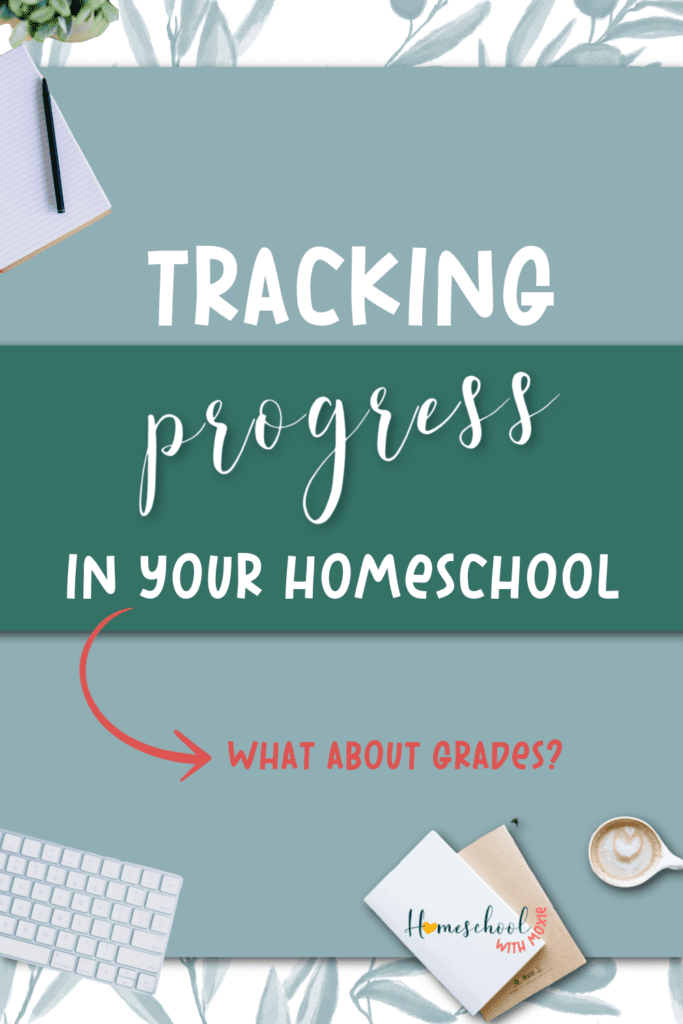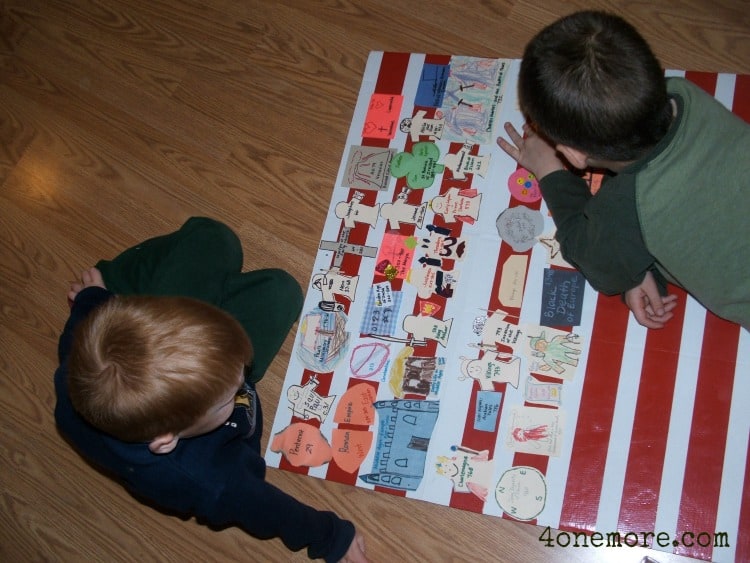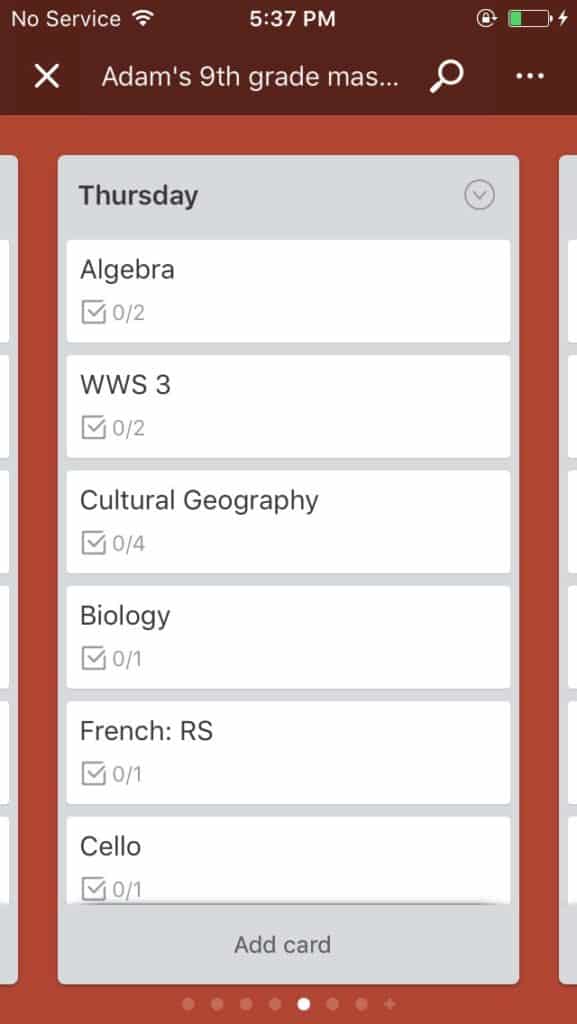The goal of education is not to pass a test, although that seems like the holy grail of the traditional school system these days. In our home, we want to raise life-long learners. You too? Great! But we still want to track progress in our homeschool. How will we know if goals are met without some kind of benchmark? Let’s talk about tracking progress in your homeschool and see what it looks like at different age levels. Plus, we’ll answer the question “what about grades?”
There are a few freebies in this post including end-of-the-homeschool-year FREEBIE summary pages and a student grade sheet.

This post contains affiliate links.
What tracking progress means in a traditional classroom setting
With federal dollars tied up in test scores, schools, administration, and teachers are pressured to turn the educational model into an assessment monster. The goal in schools across the country is to improve on standardized test scores. Unfortunately, these tests assess your agility at test-taking. There is no good way of testing for problem solving, creativity, collaboration, or communication skills. All of these skills, by the way, are the exact skills that your kids will need as they enter the job market in the next decade. Check out this amazing revelation by Google.
And if you want to read more about why the education system is broken (and why you should not be replicating school at home!), then grab a copy of Most Likely to Succeed. It will rock you world and give you a vision for what homeschooling can mean to your child. We have the freedom and flexibility to educate future innovators, not test takers!
So, why do teachers give tests in a classroom? Simply, they need an objective way to determine whether or not the learning goals have been met. When you have two dozen kids in one class, it would be a poor use of time to individually talk to each child to find out if they understand the material. Enter the multiple choice test. Quick to take. Easy to grade. Perfect bell curve results. Has your child actually understood the concepts? Maybe, maybe not. But if most of the kids pass the test, the teacher can move on to the next chapter.
Here’s the beauty of homeschooling: you know at any given moment if your child understands the concepts they are learning. You know if they “get it” or not. Take this nugget of truth with you as you consider how to track progress in your homeschool.
How to Know if Your Child is Really on Track
When you’re the homeschool parent, it can feel overwhelming at times to know if your child is on track or not in their learning. But what does that actually mean? This episode of the Homeschool with Moxie Podcast will give you actionable strategies and mindset shifts necessary to encourage progress.
Listen to episode 220:
Tracking Progress in Your Homeschool K-8
The Philosophy of Education K-8
Remember, your kids will never master everything. Rather, you want to give them exposure to many topics, living books, experiences, and opportunities. Make sure the key objectives are met, mainly in language and math competency. Kids are naturally curious and love to learn new things. Ever spend time with a toddler? Let’s not school it out of them.

The Educational Approach in K-8
As the homeschool parent, you have the great opportunity to function as a tutor. This is the best educational model. You could also call it a one-on-one approach. This is the dream of teachers everywhere. A classroom teacher with 20 or so students is not going to be able to meet each child’s needs and assess where they are in the learning process. As the homeschool mom, you can do this! Even if you have multiple children in your home, you can still use this tutoring approach.
Practical Solutions
Because you know where your child is academically at any given moment, you don’t have to rely on reams of written work to “prove” or assess that learning has occurred. This is exactly why I don’t use printables (and you shouldn’t either). You also do not need to give numerical or letter grades in K-8. There’s really no point. My kids know what they’re good at and what they need to work on. I know this too. Grades are for institutional systems.
There are so many ways to track and show progress in the early and middle years. Things like:
- Narration
- Notebooking (especially in science and history)
- Creating Portfolios of creative work

I’ve included more hands-on ideas HERE rather than using a constant flow of written work. (Disclaimer: Yes, we use written work over here, especially as the kids get older. But it’s usually student-created written work, like paragraphs, outlines, stories, math problems, creative projects or summaries.)
Learn how to put narration & notebooking to work in your homeschool.
Do things change in high school? Yes and no.
Tracking Progress in Your Homeschool 9-12
Homeschool High School
In high school, the focus will turn from exposure to a wide range of topics in K-8 to skills like rhetoric, which includes piecing complex ideas together and seeing the connections between them (remember what Google said.) Definitely check with the laws of your state regarding transcripts and graduation requirements.
If your child is going to college, check into what subjects you will want to have on the transcript. Can you add internships and apprenticeships? How about an entrepreneurial path? Maybe your child will start a fledgling business in high school. The opportunities are endless. They’re already in the real world. Let them run with their passions.
Homeschool Roles
Your role as the homeschool parent will change into more of a coach, mentor, and manager during these last years. Hopefully, your child is able to learn independently, fulfill responsibilities, and get the work done. Your job is to help craft opportunities for his passions, strengths, requirements, and skills to collide.
Practical Solutions
In almost every circumstance, you should create a traditional transcript for your high schooler, complete with grades and a GPA. This is just what our society expects, and many times you will need it to graduate them from homeschool and apply to colleges or jobs.
When they begin high school, create a notebook where your student files all their objective tests, quizzes, papers graded with a rubric, and so on. Each quarter, or at least a couple times a year, figure their numerical grade. When you reach the end of the year, fill in the course names and their final grade. If you take time to do this as you go, you won’t be left scrambling at the end of their school career trying to remember which courses they took.
On a daily basis, have a work organization system so your high schooler is accountable to complete the assignments each day. Here are the practical solutions we’re using for high school:
- Trello : This FREE online organization system provides an easy way for me to communicate which assignments are daily, which are weekly, and I can remind them of chores and additional responsibilities as well. My teens can check their Trello board on any device. If our schedule changes, Trello makes it easy to rearrange the schedule, while still getting our weekly responsibilities done. Check out Trello HERE. It’s a useful productivity platform for homeschool families.

- Time-Spent Calendar : We will be implementing this strategy as an accountability and record-keeping system for high school. I purchased an undated yearly planner at the dollar store for my two high schoolers. Each day they will record the subjects they work on and the times. This way, I can keep track and make sure we spend the 45 minutes daily / 5 days per week to earn a credit. This also helps them notice if they waste time during the school day. Or what about when you think you’ve worked on something for an hour, but it’s only been 20 minutes? Like their instrumental practice. Um, yeah. I’m hoping this simple tweak with help with productivity this year.
What’s the bottom line? Embrace your unique opportunity to know your child’s educational progress on a daily basis. Don’t do school at home. Meet your child right where they’re at and find ways for them to flourish in their giftings. Let’s raise life-long learners.
You can grab some cute themed FREEBIE Homeschool Year Summary pages by signing up below.
Listen to the Podcast: To Grade or Not to Grade?
On episode 157 of the Homeschool with Moxie Podcast, we’ll talk about whether or not you should assign grades in your homeschool.
- What is the purpose of grading?
- Do you know what mastery learning is and do you use it on your homeschool?
- Do you take advantage of immediate feedback?
- Download the grading sheet and transcript template we use in 9th-12th grades
Our favorite open & go, homeschool-friendly curriculum that encourages mastery learning:


